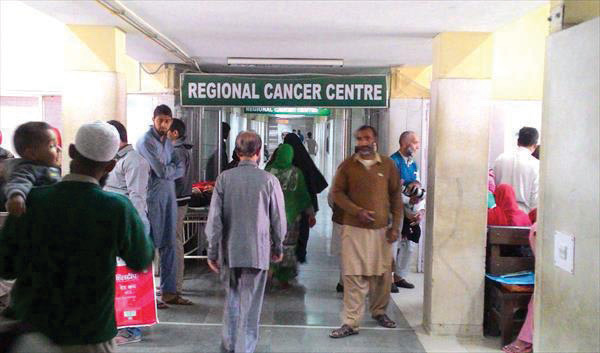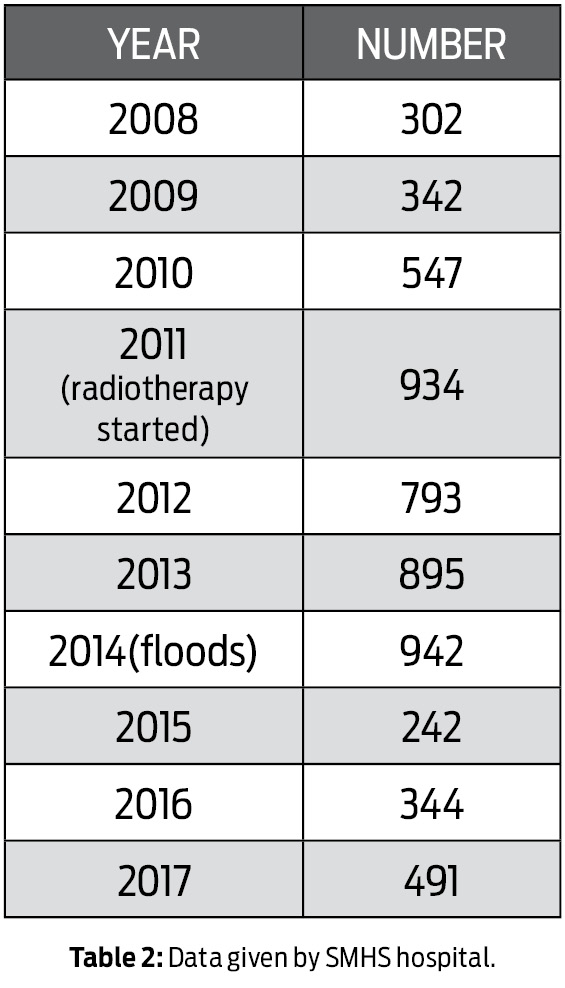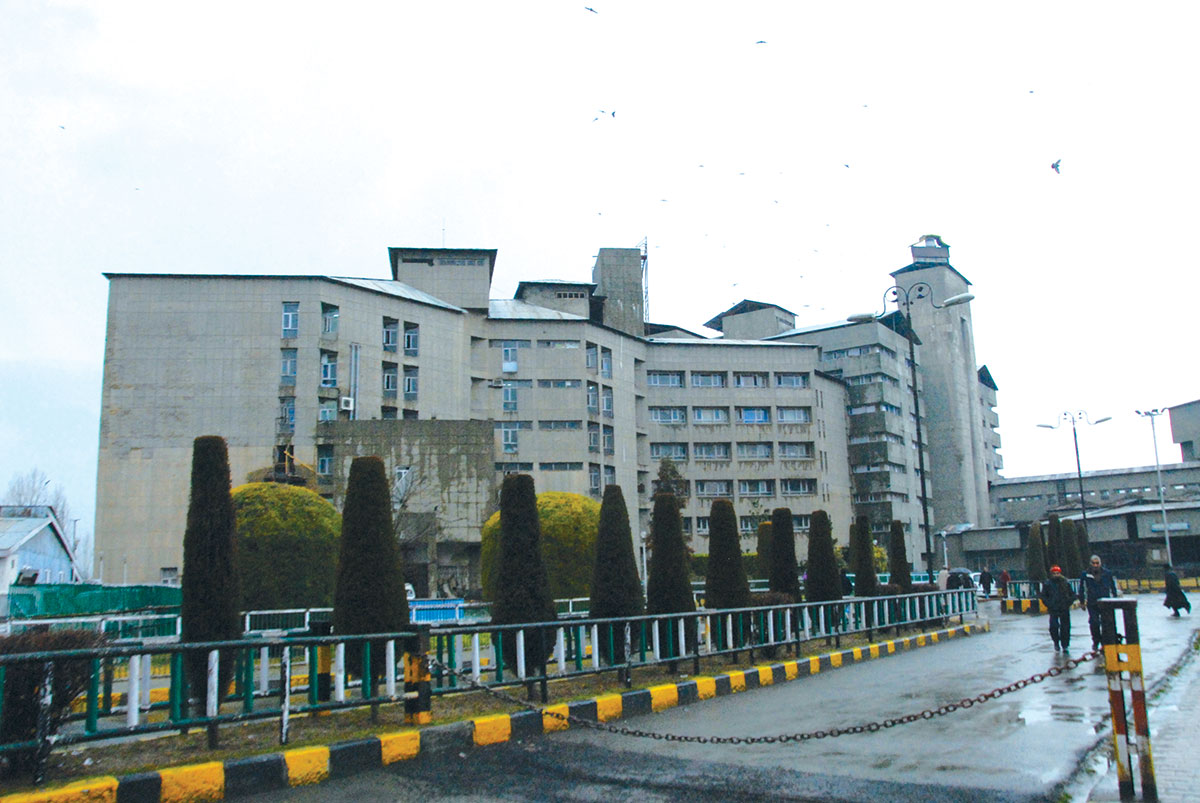There is no single stop where one can get the exact details of the state and status of cancer in Kashmir because the state lacks a single-line registry system. But the data scattered across hospitals suggest that the numbers are up and the malignancy is diverse, reports Saima Bhat

The entry to Regional Cancer Centre at the SKIMS Soura
In 2009 when 31-year-old Tanzeela, a private school teacher went to have a bath, she noticed a lump in her left breast. Once out, frightened, she revealed this to her husband, Younis Ahmad.
The panicked couple first tried to ignore it as the lump was not causing her any pain. But both had weird thoughts of what it could be. Younis, a worker at medical college Bemina, he had seen the worst of such discoveries.
Mother of two, Tanzeela left her two daughters, aged 6 and 2, with her brother and accompanied Younis to a surgeon. Doctor’s diagnosis was vindicated by FNAC tests and the mass was first-stage breast cancer.
Devastated by the revelation, they consulted their family doctor and finally landed in SKIMS Soura, Kashmir’s tertiary care hospital.
After many consultations and range of investigations, the oncologists decided to go for a surgery, as the disease was localised to Tanzeela’s one breast only, followed by chemotherapy and radiotherapy.
The doctors told her she had better chances of survival and quickly removed her disease-infested breast. Later, she was suggested to come for a session of chemotherapy, of six doses and around 22 radiotherapy sessions in the hospital’s Regional Cancer Centre (RCC).
After the twin therapies, she was put on medicines for five years with regular tests and follow-up. By then, she had shifted to her eldest brother’s home where they (Tanzeela’s family) stayed for almost five years.
Tanzeela was absolutely doing well and her medical tests indicated her well-being. After five years the couple decided to return home. For the next two years, the family lived happily and Tanzeela took all charges of her house again.
In November 2016, she started complaining of pain in her hip. “We neither knew the reason nor we thought it could be re-growth of the disease,” says Hajira, her eldest brother’s wife, who spent most of her time with Tanzeela.
Her oncologist suggested her to undergo all tests again. It was her bone scan that showed a stain on one of her hip joint. “Unfortunately it was metastasis, development of cancer growth from a distance of primary growth,” says Dr Sumaira, at RCC, under whose supervision she was given radiotherapy.
Youngest among her siblings, Tanzeela was orphaned when she was a toddler and was brought up by her other siblings. “We take her care like our own daughter,” says Hajira.
When Tanzeela’s bone scan showed a stain, her doctors suggested ‘radiotherapy will help her because the stain was in the form of a layer and not so deep.’

Table 1: New cases registered in RCC, SKIMS, Soura
This time Tanzeela was taken to Delhi for a PET scan where they consulted renowned Kashmiri oncologist, Dr Sameer Kaul.
Dr Kaul helped her to get in contact with an orthopaedician and finally it was decided patient’s hip joint needs to be removed.
“After the surgery, a few tests were repeated and doctors said we must revisit the doctors after six months. We were there on February 15, 2017, and we repeated PET scan.” In Delhi, Hajira says they were more satisfied because of the fast treatment and they asked Dr Sameer to give in writing that Tanzeela neither needs any therapy nor any medicines.
The whole family was happy that Tanzeela was doing well. By now her daughters had grown up. In her routine checkups, in July 2017, she was asked to go for another bone scan. “We were shocked to see the stain in one more bone. We again went to Delhi for a PET scan and it proved metastasis in another bone. But this time we came back to SKIMS,” Hajira said.
Hajira still accompanies Tanzeela for her radiotherapy sessions in SKIMS. Her doctors wanted her to go for a session of chemotherapy as well but the family believes Tanzeela is too weak to afford it.

Table 2: Data given by SMHS hospital.
At RCC, Tanzeela is one of the many breast cancer patients. Records suggest that the number of breast cancer cases have increased: against 186 patients in 2013, there were 225 in 2014, 271 in 2015, 258 in 2016, and in 2017, 275 new patients were registered.
The oncology department has three verticals: the surgery department, the medical oncology, where patients are given chemotherapy and the radiation department where patients are given radiotherapy.
Dr Maqbool Lone, the SKIMS Radiation Oncology head while referring to the patients who have reported to RCC, said the trend is changing. “In Females the breast cancer has shown an increasing trend while as in males the cancers of lung and prostate are up.”
They said they have been doing camps in various educational institutions and far-flung areas, where they make females understand how to do a self-examination. But in case, patients turn up at SKIMS, the hospital lacks a mammography machine functional for many years now.
“We have gone for tendering and most probably we’ll get a machine soon. Presently we have to refer our patients to either SMHS or to private clinics,” Dr Lone said.
Breast cancer, according to Lone is lifestyle-related because Kashmiri’s have changed the marriage age. “Most people go for marriage after 30 years because they focus on their careers first,” Dr Lone said. “First late marriages and then late childbirth, use of contraceptives, low physical activity, less breastfeeding: all these things cumulatively get our females more prone to breast cancers.”
Cancer has changed its universe in Kashmir. The RCC registrations are up but Dr Lone believes the number is increasing gradually but is not alarming.

Table 3
“International average is 300 new cases per 100,000 population and the national average is 100 new cases per 100,000 population. When it comes to Kashmir the average remain between 70 to 75, which is much below than the national and international average. But yes it is increasing at a good rate and in the last ten years (since 2008) it has doubled.” (see table1)
Data from another major hospital, the SMHS, also shows an increase. (see table 2).
Dr Lone believes the number of registered patients might have increased because the quality of patient registration has improved. SKIMS has a hospital-based cancer registry (HBCR): whosoever comes to RCC SKIMS, they register that patient first.
An oncologist at SMHS hospital, however, said Kashmir doesn’t know the exact number of cancer patients. “Many patients go to SKIMS, a few come to SMHS as well, a few go-to an NGO, Cancer Society of Kashmir (CSK), three privates clinics at Dr Shaad Salim, Florence Hospital and Khyber Hospital and other than that around 30 per cent of patients directly fly to Delhi and Mumbai, and these patients are not registered anywhere or they go to every facility available. But the crisis is that we don’t have a single registry system, most of the patients have duplication,” he said.
The cancer registry system is of two types: hospital-based registry system and population-based registry. HBCR was started in 2011 at SKIMS when the hospital was given the status of the RCC. The SMHS hospital was trying hard to get HBCR or the population-based registry in the state that assembly approved in 2018) but it was awarded to SKIMS. But there is a dire need for a single registry system where all the cancer patients of Kashmir should be registered under one roof and then they can take treatment wherever they want.
The SMHS started its radiation department in 2008 but made it operational in 2011 only. It remained crowded as the radiotherapy machine in SKIMS was waiting for reloading. But the gloom started in the department after 2014 floods which damaged the machines completely.
The department was providing consultations but they had to send their patients to SKIMS for radiotherapy and all the patients got registered again. The machine is functional now and the patients have started coming again.
Over the years, the type of cancer has also changed. The oldest records have shown 30 cases of skin cancer in Kashmir in 1866 when overuse of Kangri in winters used to damage the skin cells beyond the scope of treatment. While the change in life-style has eradicated it, the new malignancies emerged. Oesophagus and stomach cancers remained at number one for many decades. But now experts claim lung, colon, breast and prostate cancers are more common.
RCC figures suggest the lung cancer is topping the list followed by oesophagus, stomach and breast. The SMHS hospital data show oesophagus and stomach cancer topping the list. (table 3)

Outside view of SKIMS Srinagar.
Experts attribute this to lifestyle changes. “Now vegetables are more dangerous than mutton because of overcooking, and then the use of chemicals used for ripening of the food,” one doctor said.
Busy with his planning to go for higher studies or continue his job at a private company, Hayat, then 30, complained of being tired always with low blood pressure. He consulted a local doctor who suggested him to check his blood count and the results were shocking – he had only eight pints. He never had any injury or surgery. He was suggested to consult a gastroenterologist surgeon, who asked him to go for a stool test, faecal occult blood test (FOBT), lab test used to check stool samples for hidden (occult) blood. Occult blood in the stool may indicate colon cancer or polyps in the colon or rectum — though not all cancers or polyps bleed.
Hayat’s FOCT was positive and then his colonoscopy showed grade III cancer, with a mass of 3-4 cms. He was prescribed to go for emergency surgery and he opted to do it in SKIMS. Post recovery, he underwent chemotherapy of 12 cycles.
For the next year, Hayat said he was doing better but his parents did not allow him to resume his routine. “I don’t smoke but during my job, I had to be in the field for four days a week and during those days my lunch could be anything from barbecues to tikka and it continued for almost six years,” Hayat said. His doctors have attributed his health crisis to his food habits.
With the increasing trend of having street foods, the number of cancers have also increased and experts believe the use of tastemakers and colouring agents used in the food could be a reason.
Dr S Muhammad Salim Khan, head of social and preventive medicines (SPM) department, told Kashmir Life that the dyes that are used for adding colour to food: erythrosine for adding red colour, which stands banned since 1999 in USA, for causing cancer in animal and tartrazine for yellow colour that is responsible for hypersensitive behaviour in kids and adrenal tumours in animals. And these dyes are still used in Kashmir and Dr Salim is apprehensive about the use of preservatives in packed food items as there is no mention of such chemicals on the packets.
Dyes apart, Dr Sumaira said the use of oil is adding to the crisis. “After heating oil, it doesn’t remain edible, but they keep on frying eatables in it till it becomes like dark coal and thick, making it more carcinogenic,” Dr Sumaira said. “In our homes, we see our mother’s over fry the vegetables in oil, and the use of readily available spices, are very dangerous for our health.”

Table 4
Experts believe environmental changes including the excessive use of fertilizers and pesticides in developing countries have a direct impact on people’s lives. A study done by SKIMS on 432 brain cancer patients in Kashmir (between 2005 and 2008) reveal that 389 patients who died were orchard farmworkers, residents living near orchards, or simply those children who play in the area. And it affects female puberty as well.
Kashmir based experts claim the exposure to endocrine-disrupting chemicals (EDCs), which are present in organochlorine pesticides, plastics, fuels, and other industrial chemicals, have caused havoc in Kashmir.
One of the leading endocrinologists has a different take on the excessive exposure to pesticides and other industrial chemicals causing infertility or even brain cancer. “It is not technically possible in Kashmir to find out that hormonal imbalance is caused by food chemicals. However, researches done in Europe and the USA blame food chemicals only,” he said.
At RCC, Sameer, 8, wearing a mask hides behind his mother when the doctor asks him anything. Shy Sameer was just 28 months old, in 2013, when he was diagnosed with acute leukaemia.
Residents of Budgam, his father, 35, a labourer, recalls a few consultations with a local doctor. But the use of medicines did not help Sameer much. “His fever and chest congestion was not going and meanwhile we realised he was not eating food properly. So we consulted a paediatrician in Srinagar who suggested us to go for a few blood tests and then asked us to go to GB Panth hospital.”
There, the doctors broke the news that Sameer was having acute leukaemia and suggested them to consult a medical oncologist at RCC SKIMS.
At SKIMS, doctors put him under a few sessions of chemotherapy and later on supportive medicines. But when he was in remission, Sameer’s tests showed relapse in one of his testes. Doctor’s immediately shifted him to the theatre and removed his testes. Surgery was followed by chemotherapy and radiotherapy.
Since then Sameer’s family shifted to his maternal house, who are taking the care of the whole family and Sameer’s parents remain free to be with him and consult doctors whenever needed. The family got in touch with a local NGO, CSK, who provided him with some medicines for free of cost and as suggested by doctors he applied for CM’s Fund as well. “My case was for Rs 2.50 lakh. No doubt SKIMS provides us radiotherapy free but the supportive drugs are very costly. But the district administration just released Rs 50,000 on his behalf,” says Sameer’s father.
Sameer’s brother, elder to him by a year, and youngest sister who is 3 years old, are all normal. Sameer’s father says nobody has ever complained of any such disease in his whole family.
In February 2018, Sameer along with his parents was again in the corridors of RCC and this time he had the relapse in his brain and it was his 13th dose of radiotherapy. “Leukaemia patients do get relapse and testis and brain are most commonly affected,” says Dr Asiya. “As per new protocol, we start with radiotherapy on the brain from their early diagnosis but we all know their chances of survival are rare.” Asiya is there for four years and frequently sees kids with leukaemia.
Another observation that doctors have is that they are now tackling a fairly younger population than the earlier decades. “We have many patients, both males and females, who are in the early or mid-twenties and mostly they have colon cancers,” says Rafaqat Hussain, a senior technician at RCC. He also says since January 2018 to February 06, he has given radiotherapy to 383 patients, in just 38 days and most of them belonged to Srinagar district. (table 4)
Experts believe the disease like prostate, is a silent killer where bones get involved and the patient doesn’t know. Meanwhile, patients with oesophagus are considered to be lucky because they get symptoms very early.
Dr Lone said his hospital has almost all facilities available and patients need not go outside for the treatment. “I understand we have a huge rush of patients. We tackle a population of 71 lakhs but we manage them all. But we need to have at least four more units to manage all patients.”

SMHS, Srinagar.
The hospital has now a PET scan, the facility that helps them for staging. “It is not for cancer detection but just to check the staging. And in just one month, the patient’s list reached 80,” Lone said.
The experts say they receive 70 per cent patients who reach the hospital in late stages but still, they are treated and helped for, so not to die a painful death.
(All the names of the patients and their relatives have been changed to protect their identities.)
from Kashmir Life https://ift.tt/2Shn4eP
via IFTTThttps://kashmirlife.net
No comments:
Post a Comment